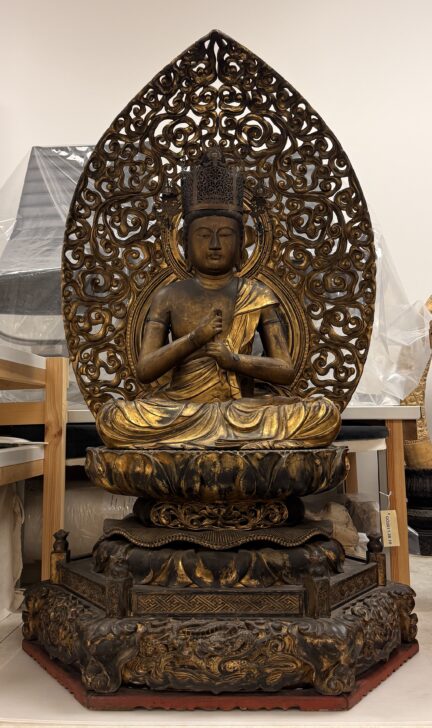Vairocana Buddha (J. Dainichi Nyorai)
Japanese

Description
This radiant, crowned, bejeweled, and youthful Buddha, with long locks piled high on his head and wearing a loincloth-like dhoti, evokes the appearance and manner of an Indian prince rather than a simple monk. Representations of Buddha as a prince come out of a tradition that stressed the royal origins of the historical Buddha Shakyamuni, before he abandoned secular life. The imagery of a more “godlike” Buddha emerged in the late seventh to early eighth century in India as a response to the growing popularity of Hinduism. Not surprisingly, these resplendent images appealed to great emperors and petty princes alike and, from Tibet to Indonesia to China and Japan, they dominated the great royal Buddhist temples of the eighth century.
This particular image is identified as Vairocana (Great Radiance) by his gesture of clasping his left forefinger with his right hand, symbolizing the philosophical notion of “the union of six elements”: earth, air, fire, water, and wood, all subsumed into the mind. It was made in Japan, probably in the late seventeenth or early eighteenth century, in a style that consciously looks back to the work of the late twelfth and early thirteenth centuries. The image and its halo and dais are all carved from wood that was hollowed out, coated with gesso, and then lacquered and gilded. When new, the ensemble would have been a dazzling gold, but it has taken on a beautiful patina as the gilding has worn away.
(Label for UMMA Japanese Gallery Opening Rotation, March 2009)
Usage Rights:
If you are interested in using an image for a publication, please visit https://umma.umich.edu/request-image/ for more information and to fill out the online Image Rights and Reproductions Request Form.